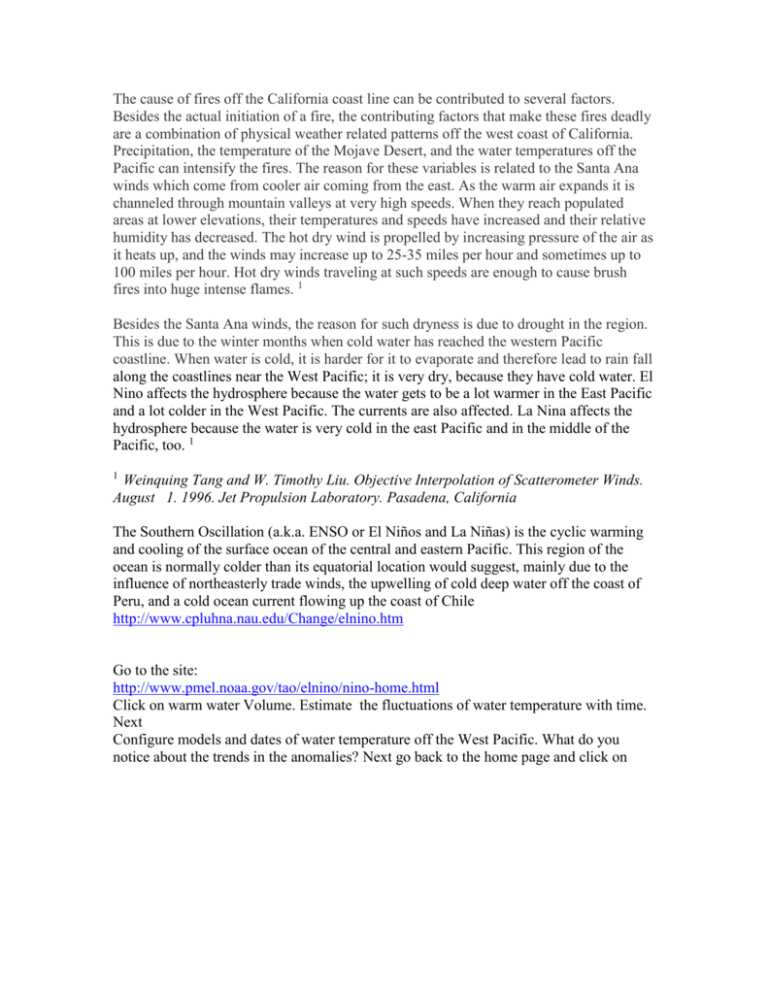Cycle C
advertisement

The cause of fires off the California coast line can be contributed to several factors. Besides the actual initiation of a fire, the contributing factors that make these fires deadly are a combination of physical weather related patterns off the west coast of California. Precipitation, the temperature of the Mojave Desert, and the water temperatures off the Pacific can intensify the fires. The reason for these variables is related to the Santa Ana winds which come from cooler air coming from the east. As the warm air expands it is channeled through mountain valleys at very high speeds. When they reach populated areas at lower elevations, their temperatures and speeds have increased and their relative humidity has decreased. The hot dry wind is propelled by increasing pressure of the air as it heats up, and the winds may increase up to 25-35 miles per hour and sometimes up to 100 miles per hour. Hot dry winds traveling at such speeds are enough to cause brush fires into huge intense flames. 1 Besides the Santa Ana winds, the reason for such dryness is due to drought in the region. This is due to the winter months when cold water has reached the western Pacific coastline. When water is cold, it is harder for it to evaporate and therefore lead to rain fall along the coastlines near the West Pacific; it is very dry, because they have cold water. El Nino affects the hydrosphere because the water gets to be a lot warmer in the East Pacific and a lot colder in the West Pacific. The currents are also affected. La Nina affects the hydrosphere because the water is very cold in the east Pacific and in the middle of the Pacific, too. 1 1 Weinquing Tang and W. Timothy Liu. Objective Interpolation of Scatterometer Winds. August 1. 1996. Jet Propulsion Laboratory. Pasadena, California The Southern Oscillation (a.k.a. ENSO or El Niños and La Niñas) is the cyclic warming and cooling of the surface ocean of the central and eastern Pacific. This region of the ocean is normally colder than its equatorial location would suggest, mainly due to the influence of northeasterly trade winds, the upwelling of cold deep water off the coast of Peru, and a cold ocean current flowing up the coast of Chile http://www.cpluhna.nau.edu/Change/elnino.htm Go to the site: http://www.pmel.noaa.gov/tao/elnino/nino-home.html Click on warm water Volume. Estimate the fluctuations of water temperature with time. Next Configure models and dates of water temperature off the West Pacific. What do you notice about the trends in the anomalies? Next go back to the home page and click on satellite images Compare how the water temperature is affected by El Nino. Click on the download data, and compare data readings and standard deviations. Is there a pattern with these water temperatures? How do the water temperatures differ by location? Compare your results with other groups. Compile data, and analyze results. What is the final conclusion? Next go to the following link: http://www.cpc.ncep.noaa.gov/products/predictions/multi_season/13_seasonal_outlooks/ color/page2.gif http://www.pmel.noaa.gov/tao/elnino/forecasts.html#climate Please look up US Drought Monitor. What does this current map relate to the southern California wildfires? Compared the time scale to the water temperatures off the west Pacific. How do the two relate? Is there a correlation between drought and water temperature? Next click on 3-month temperature and precipitation outlook. What does the data predict as far as precipitation? Compare the results from drought to precipitation and decide how they correlate. Next decide which month would be the most severe for a wildfire in the west coast of the Pacific. Compare your results with other groups. What is the optimal condition for fire conditions? Finally do a research on the effects of El Nino, La Nina, on wildfires in the US, and compare the data findings to this research. How do they relate? Simard, A.J., Haines, D.A., Main, W.A. : Relations between El Niño/Southern Oscillation anomalies and wildland fire activity in the United States : Agricultural and forest meteorology v. 36 (2) p. 93-104 Swetnam, T. W. : Fire history and climate in the southwestern United States : General Technical Report - US Department of Agriculture, Forest Service, RM 191, pp 6-17 Swetnam, T. W., Betancourt, J. L. : Fire-Southern Oscillation relations in the southwestern United States : Science, v249 n4972, pp 1017-1020











